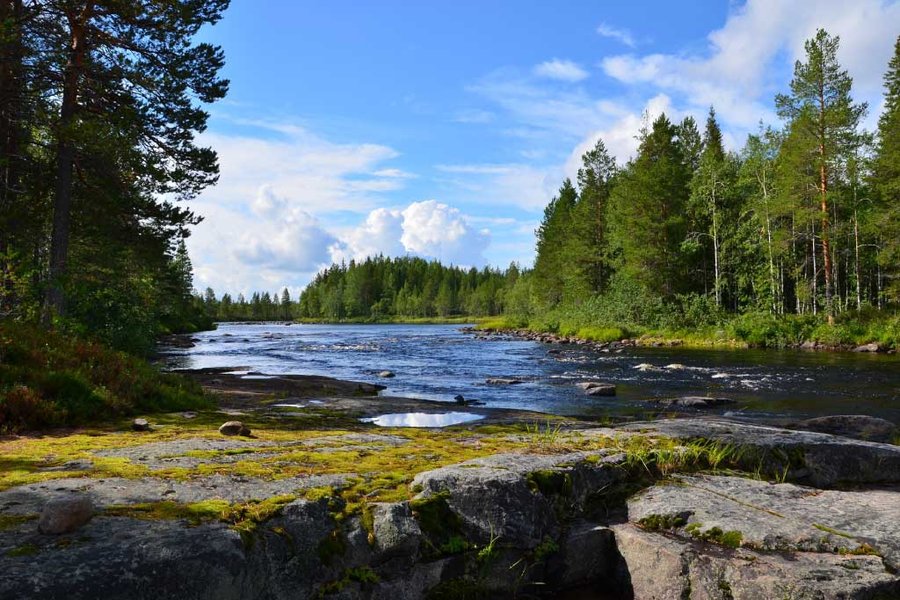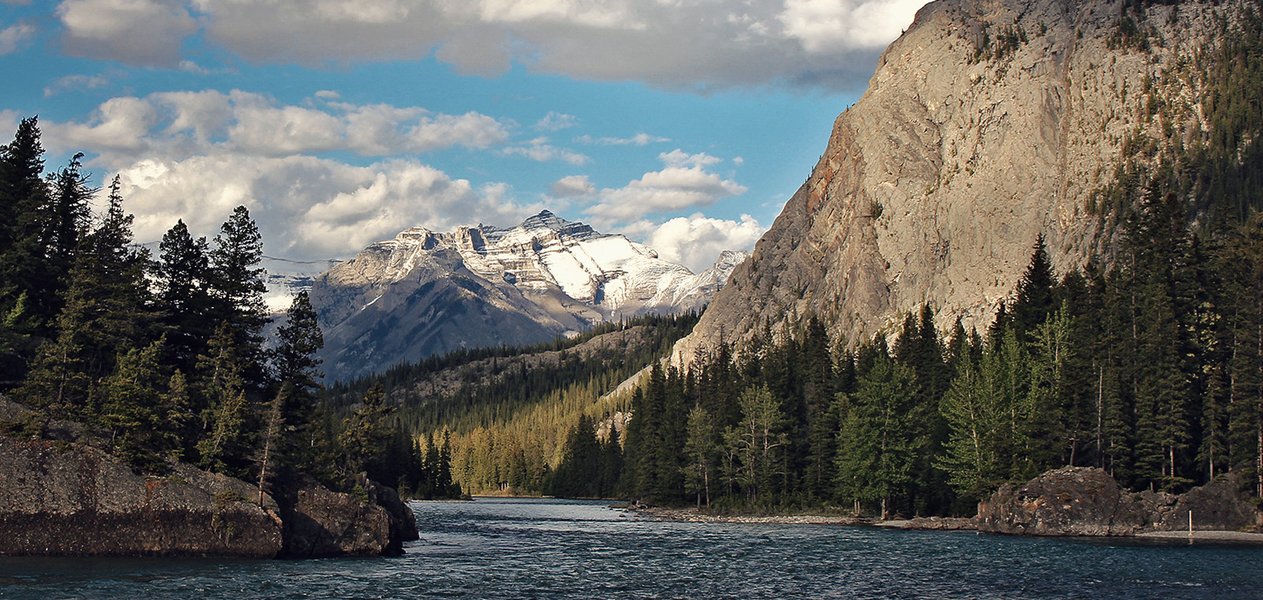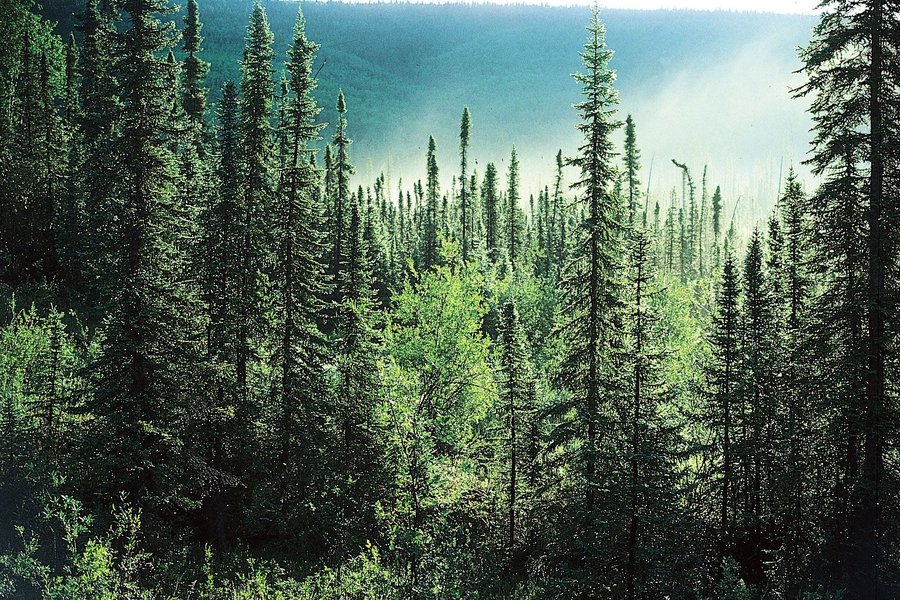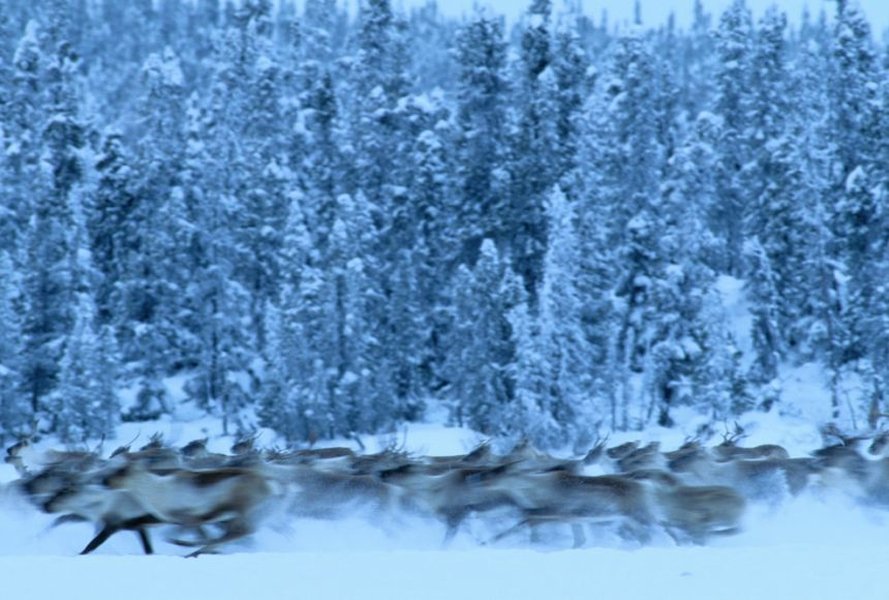
The Taiga Unveiled: Journey Through Earth's Vast Boreal Realm
An in-depth exploration of the world's largest land biome, its climate, unique life, and critical global role.
The term "Taiga" evokes images of immense, snow-dusted forests stretching across vast northern landscapes. While this primarily refers to the expansive boreal biome, it's worth noting that "Taiga" also lends its name to various modern enterprises. These include Taiga Company (sustainability consulting), Taiga Motors (electric off-road vehicles), Taiga PM (open-source project management software), and TAIGA (cash management training services). These entities often draw inspiration from the biome's connotations of resilience, vastness, or natural purity. However, this comprehensive exploration is dedicated to the Taiga biome itself – the colossal ecosystem that shapes our planet.
Highlights of the Taiga
- World's Largest Land Biome: The Taiga, also known as the boreal forest, forms a continuous belt across the Northern Hemisphere, covering approximately 11.5% to 17% of Earth's land surface, making it more extensive than any other terrestrial biome.
- Conifer Dominance: It is characterized by dense forests of coniferous trees like pines, spruces, and larches, all uniquely adapted to survive long, harsh winters and short growing seasons.
- Critical Global Role: Taiga forests are vital for global climate regulation, acting as massive carbon sinks that store vast quantities of carbon, and they play a significant role in producing oxygen and housing extensive freshwater ecosystems.
What is the Taiga?
Defining the Boreal Giant
The Taiga, also known by names such as the boreal forest or snow forest, stands as a colossal ecological system. It is primarily defined by its extensive coniferous forests, a seemingly endless expanse of trees like pines, spruces, and larches. As a biome, it represents a very large ecological community of plants and animals adapted to its specific climate and environmental conditions. It forms a distinct band across the globe, separating the treeless Arctic tundra to its north from the more temperate forests and grasslands to its south.
Etymology: The Roots of the Name
The term "Taiga" itself has origins in the Russian language, where it simply means "forest," particularly referring to the swampy, coniferous forests of Siberia. This nomenclature reflects the biome's significant presence and character within these vast northern territories. The alternative name, "boreal forest," comes from Boreas, the Greek god of the north wind, aptly describing its northern, cold-dominated nature.

A characteristic view of the Taiga, showcasing its dense coniferous forests and water bodies.
Geographic Expanse: A Global Belt of Green
Circumpolar Dominion
The Taiga biome forms a massive, continuous circumpolar belt across the Northern Hemisphere, typically situated between 50 and 70 degrees north latitude. It stretches across several continents:
- North America: Covering most of inland Canada and Alaska, with extensions into the northernmost parts of the contiguous United States.
- Europe: Spanning across Scandinavian countries like Norway, Sweden, and Finland.
- Asia: Dominating vast regions of Russia, particularly Siberia, where it forms the largest continuous forest on Earth, stretching approximately 5,800 kilometers (3,600 miles) from the Pacific Ocean westward.
It lies strategically south of the Arctic tundra and north of temperate deciduous forests or grasslands, acting as a crucial transition zone.
Size and Scale
The Taiga is recognized as the world's largest terrestrial biome. Estimates of its coverage vary slightly but generally indicate it occupies between 11.5% and 17% of the Earth's total land area. This equates to roughly 17 million square kilometers (6.6 million square miles), an area so vast that it significantly influences global climate patterns and biodiversity.

The Taiga biome in Banff, Canada, illustrating its mountainous terrain and extensive coniferous tree cover.
Climate: A Realm of Extremes
Seasonal Rhythms
The climate of the Taiga is classified as subarctic and is characterized by stark seasonal contrasts. Winters are long, exceptionally cold, and severe, with average temperatures often plunging well below freezing. Temperatures can reach as low as -54°C (-65°F). Heavy snowfall is common, blanketing the landscape for many months. In contrast, summers are short, generally mild to cool, and relatively humid, with temperatures occasionally rising to 21°C (70°F) or slightly higher in some southern areas. The growing season is brief, typically lasting only 50 to 100 days, which significantly limits the types of vegetation that can thrive.
Precipitation Patterns
Precipitation in the Taiga is moderate, ranging annually from approximately 200 mm to 600 mm (8 to 24 inches). Much of this precipitation falls as snow during the long winter months, contributing to a significant snowpack. Summer brings rainfall, though the overall environment remains relatively dry compared to more temperate forest biomes. The low temperatures mean that evaporation rates are also low, allowing the moisture to persist despite the moderate precipitation levels.
The Subarctic Influence
Located just south of the Arctic Circle, the Taiga is heavily influenced by cold arctic air masses. This results in the characteristic bitterly cold winters. The biome's vastness also means that continental climate effects are strong, leading to wide temperature variations between winter and summer, and even between day and night.
Flora: The Hardy Coniferous Kingdom
Dominant Conifers and Their Adaptations
The vegetation of the Taiga is overwhelmingly dominated by coniferous trees. These species are exceptionally well-adapted to the harsh conditions. Common genera include:
- Pines (Pinus spp.)
- Spruces (Picea spp.)
- Larches (Larix spp.)
- Firs (Abies spp.)
- Cedars (though true cedars are less common, other Cupressaceae members fill similar niches)
These trees exhibit several key adaptations:
- Needle-like leaves: These reduce surface area, minimizing water loss through transpiration, which is crucial during dry winters when water is frozen. The needles often have a waxy coating for further protection.
- Evergreen nature: Most conifers in the Taiga are evergreen (except for larches, which are deciduous conifers). This allows them to begin photosynthesis as soon as temperatures permit in spring, without needing to regrow leaves.
- Conical shape: The characteristic cone shape helps shed heavy snow, preventing branch breakage.
- Dark color: The dark green of the needles helps absorb more sunlight for warmth.
Understory and Forest Floor
The dense canopy of coniferous trees often limits the amount of sunlight reaching the forest floor, leading to a relatively sparse understory in many areas. However, where light permits, or in more open woodlands, the understory can include hardy shrubs such as blueberries and cranberries, along with some grasses. The forest floor is typically covered by a thick layer of slowly decomposing needles, as well as extensive carpets of mosses and lichens. Lichens are particularly important, serving as a food source for animals like caribou.
Soil Characteristics
Soils in the Taiga are generally acidic and nutrient-poor. The slow decomposition of coniferous needles contributes to the acidity. Low temperatures also slow down the activity of decomposers (bacteria and fungi), leading to a slow rate of nutrient cycling and the accumulation of organic matter. In many northern parts of the Taiga, a layer of permafrost (permanently frozen ground) may be present beneath the soil surface, further impeding drainage and root growth. This can lead to waterlogged conditions and the formation of peat bogs or muskegs in some areas.

Towering coniferous trees, primarily spruces, form the backbone of the Taiga's vegetation.
Visualizing the Taiga's Complexity: A Mindmap Overview
To better understand the multifaceted nature of the Taiga biome, the mindmap below illustrates its core components and their interconnections. It provides a snapshot of the definition, geographical spread, climatic conditions, characteristic flora and fauna, ecological importance, and the primary threats it faces.
Scandinavia, Russia (Siberia)"] id2d["South of Tundra,
North of Temperate Forests"] id3["Climate Characteristics"] id3a["Subarctic Conditions"] id3b["Long, Severe Winters (-54°C)"] id3c["Short, Cool Summers (up to 21°C)"] id3d["Moderate Precipitation (200-600mm),
Mainly Snow"] id3e["Short Growing Season (50-100 days)"] id4["Dominant Flora"] id4a["Coniferous Trees"] id4a1["Pines (Pinus)"] id4a2["Spruces (Picea)"] id4a3["Larches (Larix) - Deciduous Conifer"] id4a4["Firs (Abies)"] id4b["Adaptations"] id4b1["Needle-like Leaves (Water Retention)"] id4b2["Evergreen (Most Species)"] id4b3["Conical Shape (Snow Shedding)"] id4c["Understory: Mosses, Lichens, Shrubs"] id4d["Soil: Acidic, Nutrient-Poor,
Permafrost in North"] id5["Adapted Fauna"] id5a["Mammals"] id5a1["Herbivores: Moose, Caribou (Reindeer),
Snowshoe Hare, Beaver"] id5a2["Predators: Wolves, Lynx, Bears
(Brown, Black), Wolverine, Fox"] id5b["Birds"] id5b1["Residents: Owls, Woodpeckers, Hawks"] id5b2["Migratory: Songbirds (Summer Breeding)"] id5c["Aquatic Life: Trout, Salmon, Pike"] id5d["Adaptations: Thick Fur/Feathers,
Hibernation, Migration"] id6["Ecological Significance"] id6a["Major Carbon Sink"] id6b["Climate Regulation"] id6c["Oxygen Production"] id6d["Freshwater Ecosystems (Rivers, Lakes, Bogs)"] id7["Threats & Human Impact"] id7a["Deforestation (Logging)"] id7b["Mining & Oil/Gas Extraction"] id7c["Climate Change"] id7c1["Permafrost Thaw"] id7c2["Increased Wildfires"] id7c3["Shifting Biome Boundaries"] id7d["Habitat Fragmentation"]
Fauna: Life Adapted to the Cold
Despite its harsh conditions, the Taiga supports a surprising diversity of animal life, all exhibiting remarkable adaptations to survive the extreme cold, deep snow, and short summers.
Mammalian Inhabitants
The Taiga is home to a range of iconic mammals:
- Large Herbivores: Species like moose (the largest deer species), caribou (reindeer in Eurasia), and various other deer species browse on available vegetation.
- Predators: A suite of formidable predators roams the Taiga, including grey wolves, lynx (Canadian and Eurasian), brown bears (grizzlies in North America), American black bears, formidable wolverines, and several species of foxes.
- Small Mammals: A variety of smaller mammals thrive here, such as snowshoe hares (with their large, snow-adapted feet), voles, lemmings, squirrels, martens, weasels, and beavers, whose dam-building activities significantly shape wetland habitats.
Avian Diversity
Birdlife in the Taiga includes both year-round residents and seasonal migrants:
- Resident Birds: Species adapted to withstand the cold winters include various owls (e.g., Great Grey Owl, Boreal Owl), hawks, eagles, and woodpeckers, which find food and shelter in the coniferous forests. Grouse and ptarmigan are also common.
- Migratory Birds: The Taiga serves as a critical breeding ground for numerous species of songbirds, warblers, and waterfowl (ducks, geese, loons) that arrive in the spring to take advantage of the brief summer bounty of insects and longer daylight hours, then migrate south before winter.
Aquatic Life and Invertebrates
The numerous lakes, rivers, bogs, and fens within the Taiga support various fish species, including trout, salmon (in rivers connected to the ocean), pike, and perch. Insect life, though limited by the cold, explodes during the short summer, providing a crucial food source for birds and fish. Mosquitoes and black flies can be particularly abundant.
Adaptations for Survival
Animals in the Taiga have evolved a variety of strategies to cope with the challenging environment:
- Insulation: Thick fur (mammals) or dense feathers (birds) provide insulation against the cold. Many animals also have layers of fat for additional warmth and energy reserves.
- Camouflage: Some species, like the snowshoe hare and ptarmigan, change their coat/plumage color from brown in summer to white in winter to blend in with the snow.
- Behavioral Adaptations:
- Migration: Many bird species and some mammals (like caribou) undertake long migrations to escape the harshest winter conditions or to find food.
- Hibernation/Torpor: Some mammals, like bears, enter a state of dormancy (hibernation or winter sleep) to conserve energy during winter. Smaller mammals may enter periods of torpor.
- Food Caching: Species like squirrels and jays store food during times of plenty to consume during leaner winter months.
- Physical Adaptations: Large paws (e.g., lynx, snowshoe hare) act like snowshoes, distributing weight to allow movement over deep snow.

The caribou, well-adapted to the Taiga's cold and snowy conditions, is a keystone herbivore in this biome.
Taiga at a Glance: Key Characteristics
The following table provides a concise summary of the defining features of the Taiga biome, offering a quick reference to its primary environmental conditions, vegetation, and typical inhabitants.
| Characteristic | Description |
|---|---|
| Also Known As | Boreal Forest, Snow Forest |
| Global Location | Northern Hemisphere (circumpolar band: Canada, Alaska, Scandinavia, Russia/Siberia) |
| Latitude Range | Approximately 50°N to 70°N |
| Size | World's largest land biome; ~11.5-17% of Earth's land area |
| Climate Type | Subarctic |
| Winter Temperatures | Long, very cold; average can be -20°C to -30°C, extremes to -54°C (-65°F) |
| Summer Temperatures | Short, mild to cool; average 10°C to 20°C, extremes to 21°C (70°F) or slightly higher |
| Annual Precipitation | Moderate: 200 mm to 600 mm (mostly snow, some summer rain) |
| Growing Season | Short: 50 to 100 frost-free days |
| Dominant Vegetation | Coniferous trees: Pines, Spruces, Larches, Firs |
| Key Plant Adaptations | Needle-like leaves, waxy coating, evergreen habit (most species), conical shape |
| Soil Type | Acidic, nutrient-poor, often thin; permafrost in northern regions |
| Key Herbivores | Moose, Caribou/Reindeer, Snowshoe Hare, Beaver, Voles |
| Key Predators | Wolves, Lynx, Brown Bears, Black Bears, Wolverines, Foxes, Owls, Eagles |
| Notable Features | Extensive freshwater systems (lakes, rivers, bogs), slow decomposition rates |
Ecosystems and Biodiversity within the Taiga
Forest Zones and Freshwater Systems
The Taiga is not a uniform expanse. It can be broadly divided into different zones based on tree density and proximity to the tundra:
- Closed-Canopy Forest: Found in the southern parts, this zone features dense stands of coniferous trees with a relatively closed canopy, limiting undergrowth.
- Lichen Woodland or Sparse Taiga: Further north, or in areas with poorer soils, the forest becomes more open, with trees more scattered. The ground is often covered extensively with lichens and mosses.
- Forest-Tundra Ecotone: At its northernmost limit, the Taiga gradually transitions into the treeless Arctic tundra. Here, trees become stunted and sparse, eventually giving way to low-growing tundra vegetation.
Beyond forests, the Taiga is rich in freshwater ecosystems, including countless rivers, streams, ponds, lakes, bogs (muskegs), and fens. These aquatic environments are integral to the biome's overall functioning, providing habitats for fish and waterfowl, and influencing local hydrology.
Biodiversity in a Harsh Environment
Compared to tropical or temperate forests, the Taiga has a relatively lower diversity of plant and tree species. This is primarily due to the severity of the climate and the short growing season. However, the species that do inhabit the Taiga are highly specialized and resilient. While species richness might be lower, the sheer abundance of individuals within those adapted species can be immense, particularly for coniferous trees and certain insect populations during summer. The biodiversity it does support is unique and critical, with many species found predominantly or exclusively within this biome.
The Taiga in Global Biome Context: A Comparative Look
To appreciate the unique characteristics of the Taiga, it's helpful to compare it with other major global biomes. The radar chart below offers a visual comparison across several key ecological factors. These values are generalized and serve to illustrate relative differences rather than precise measurements. The factors considered are Biodiversity (species richness), Annual Precipitation, Winter Severity (where a higher value indicates more severe/colder winters), Growing Season Length, Carbon Sequestration Capacity, and the current level of Human Impact.
This chart highlights the Taiga's position as a biome with moderate biodiversity and precipitation, but extreme winter severity and a short growing season. Its capacity for carbon sequestration is notably high, while human impact levels are significant and growing.
Ecological Significance: A Global Regulator
The Lungs of the North: Carbon Sequestration and Oxygen
The Taiga plays an immensely important role in global ecological balance. Its vast forests act as a significant carbon sink, absorbing enormous amounts of carbon dioxide from the atmosphere through photosynthesis and storing it in their biomass (trunks, roots, needles) and in the soil. The cold, often waterlogged soils slow decomposition, meaning carbon can remain locked away for long periods, particularly in peatlands. These forests are also major producers of atmospheric oxygen, contributing to the air we breathe.
Climate Moderation
Through processes like evapotranspiration and by influencing albedo (the amount of solar radiation reflected from Earth's surface), the vast expanse of the Taiga helps regulate regional and even global climate patterns. It influences heat exchange between the land and atmosphere and affects atmospheric circulation.
Freshwater Resources
The Taiga biome contains a substantial portion of the world's freshwater in its numerous rivers, lakes, and wetlands. These systems are vital for local ecosystems, support diverse aquatic life, and contribute to larger hydrological cycles. The slow melting of snowpack in spring provides a sustained release of freshwater into these systems.
Discover the Taiga Visually
A Glimpse into the Boreal World
The video below, "Exploring the Taiga Biome - FreeSchool," offers an engaging visual introduction to this remarkable ecosystem. It provides a look at the characteristic landscapes, flora, and fauna of the Taiga, helping to bring its unique environment to life. The video discusses the Taiga's vastness, its role in global ecosystems (covering about 11% of the planet and containing about 1/3 of all trees), and touches upon the life it supports, making it a great primer for understanding this biome.
Human Impact and Conservation Challenges
Despite its remoteness and harsh conditions, the Taiga biome is not immune to human influence and faces several significant threats.
Threats to the Boreal Forests
- Logging and Deforestation: Large-scale logging operations for timber, pulp, and paper production are a major driver of deforestation and forest degradation in many Taiga regions, particularly in Canada, Russia, and Scandinavia.
- Mining and Oil/Gas Extraction: The Taiga is rich in mineral resources, oil, and natural gas. Exploration and extraction activities lead to habitat destruction, pollution, and fragmentation of ecosystems.
- Wildfires: While fire is a natural component of Taiga ecology, helping with regeneration for some tree species, the frequency and intensity of wildfires are increasing in many areas. This is often exacerbated by climate change and human activities.
- Habitat Fragmentation: Roads, pipelines, and other infrastructure developments break up large, continuous forest tracts into smaller, isolated patches. This can disrupt wildlife migration routes, reduce genetic diversity, and make ecosystems more vulnerable.
- Pest Outbreaks and Disease: Changing climate conditions can also lead to increased outbreaks of insect pests (like bark beetles) and diseases that can devastate large areas of forest.
The Role of Climate Change
Climate change poses a particularly severe threat to the Taiga:
- Rising Temperatures: Warming temperatures are causing permafrost to thaw, which can destabilize terrain, alter hydrology, release stored carbon (as methane and CO2) into the atmosphere, and damage infrastructure.
- Shifting Biome Boundaries: As temperatures rise, the conditions suitable for Taiga vegetation may shift northward, potentially leading to a contraction of the biome and encroachment by temperate species from the south.
- Increased Wildfire Risk: Warmer, drier conditions contribute to a longer fire season and more intense wildfires.
- Impacts on Wildlife: Changes in temperature and precipitation patterns can affect food availability, breeding success, and migration patterns for Taiga wildlife.
Conservation Efforts and Sustainable Practices
Recognizing the Taiga's global importance, various conservation efforts are underway. These include:
- Protected Areas: Establishment of national parks, nature reserves, and other protected areas to conserve representative Taiga ecosystems and biodiversity.
- Sustainable Forest Management: Promoting logging practices that minimize environmental impact, protect biodiversity, and ensure forest regeneration. This includes certifications like those from the Forest Stewardship Council (FSC).
- Climate Change Mitigation and Adaptation: Global efforts to reduce greenhouse gas emissions are crucial for the long-term health of the Taiga. Adaptation strategies involve planning for changes in fire regimes, water resources, and species distributions.
- Research and Monitoring: Ongoing scientific research to better understand Taiga ecosystems and the impacts of human activities and climate change is essential for effective conservation planning.
- Indigenous Engagement: Involving Indigenous communities, who often have deep traditional knowledge of Taiga ecosystems, in conservation and management efforts.
The preservation of the Taiga is critical not only for the unique species it harbors but also for maintaining global climate stability and ecosystem services that benefit humanity as a whole.
Frequently Asked Questions about the Taiga
What does "Taiga" mean and where does the name come from?
Is Taiga the same as Boreal Forest?
Why are coniferous trees dominant in the Taiga?
What is the biggest threat to the Taiga biome?
How do animals survive the extreme cold of the Taiga winters?
Recommended Further Exploration
If you're interested in learning more, consider exploring these related topics:
- How does permafrost thaw in the Taiga impact global carbon levels?
- What are the specific adaptations of the Siberian Tiger to the Taiga environment?
- Compare and contrast the biodiversity of the Canadian Taiga versus the Siberian Taiga.
- What role do Indigenous communities play in the conservation of Boreal forests?
References
Last updated May 6, 2025